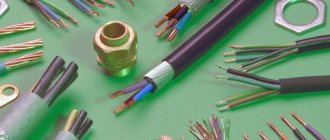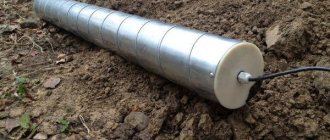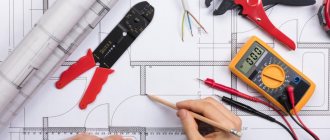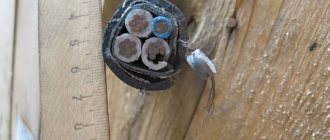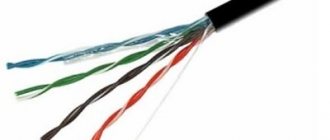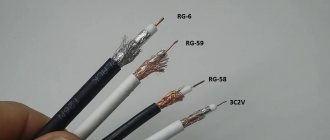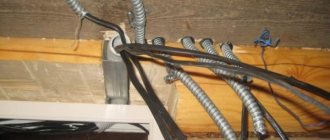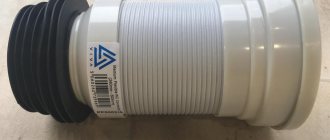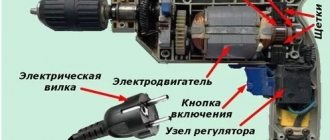Types of repairs
There is a document RD 34.20.508 “Instructions for the operation of power cable lines.
Part 1. Cable lines with voltage up to 35 kV." It distinguishes such types of repairs of cable lines at 10 kV and other voltages as planned, emergency and urgent. Planned repairs are carried out according to a schedule developed by the energy company. This document is compiled every month and is based on reports from dispatch services, results of measurements, tests, inspections and walk-throughs. Based on the monthly schedules, in turn, an annual plan for major repairs is developed, carried out in the summer.
The need for emergency repair of a 10 kV cable line or other voltage arises when, after it has been disconnected, it becomes impossible to put it back into operation, provided that the backup line is overloaded and does not allow a high-quality supply of energy to consumers. A larger or smaller number of emergency teams immediately leaves for the work site, and then the personnel act in accordance with the instructions of the dispatcher.
Urgent repair of a 10 kV cable is carried out when receivers of category I or the most important category II are disconnected from the backup power supply - provided that receivers of other categories, consuming energy, overload the operating lines and experience limitations. Repairs are carried out within the work shift in accordance with the instructions of the dispatcher.
Soldering or twisting? Features of car wiring repair through the eyes of a professional electrician
Whether to heat a car in winter or not, whether gas kills engines, soldering or twisting wires - it seems that some questions of motorists are as eternal and “holivar” as the topic of the appearance of an egg and a chicken. And the closer the season gets, the more fierce the disputes become, with no end in sight.
What to do, for example, if the wiring has finally given in due to age and high humidity? an experienced diagnostician Dmitry about this , whose many years of work experience allows us to draw some conclusions.
– Why do wires fail in general?
– If we talk about natural factors, the reasons are moisture and destruction of insulation due to an aggressive environment or simply due to age. Less often you can find not the most successful factory solutions for laying wiring. There are more artificial reasons, but they all boil down to either poor-quality intervention in the wiring, or disruption of its installation and subsequent damage due to this.
The strongest and most reliable connection is welding. It occurs in power circuits when there is no other way. Quite often, crimping is used in factory connections. This is also a fairly reliable method, but not without its drawbacks. For example, crimping thin pins often suffers from moisture.
At the same time, VAG suggests using crimping as a way to repair wiring. They even have special kits with sleeves and heat shrink tubing. Moreover, the same repair kits may contain sleeves with soldering paste inside. When the heat shrink is heated, this paste additionally solders the joint.
But still, my main complaint about the wiring in the car is the lack of soldering, with rare exceptions. Previously, I had the opportunity to work with aviation equipment - it is used everywhere there.
– And here we move on to that very eternal question...
– Soldering and twisting remain the most popular methods of wiring repair. Each master himself puts an end to this issue - it was not possible to come to any agreement and is unlikely to be possible.
In my practice, I prefer soldering. I allow the use of twists only in cases where repairs are needed “here and now.” The twists oxidize, and over time they may even fall apart due to vibration. Their advantages definitely include speed and simplicity, as well as less rigidity compared to soldering. But when the wires are neatly laid out, this does not play a significant role, and it is not worth making connections anywhere in the transition to the door - it is better to replace the wire partially or entirely, eliminating the mobility of the connection in principle.
At the same time, soldering provides a more reliable connection and is much less susceptible to moisture. It also provides the least resistance, which is what we're trying to achieve. After all, if the resistance is greater than expected, heat will be generated at the junction. This in turn can lead to deformation of the connection. This will be followed by an even greater release of heat - and so on until everything completely melts. Is it dangerous.
Moreover, it is not possible to apply twisting everywhere. In some places, due to the inconvenient location of the wires, it is simply impossible to reach them with both hands, and in others, the length of the wires does not allow twisting. When soldering, such inconvenient moments can be easily circumvented by reaching the inconvenient place with a soldering iron with a drop of solder. Or how, for example, to twist wires with a large cross-section? They can be crimped and soldered again. True, to warm it up you will have to use either a very powerful soldering iron or a torch, but this will not change the essence.
With thick wires, solutions can in principle be combined. This is what some automakers do. For example, thick ground and power wires at the transitions from wire to terminal are soldered by Mercedes and BMW.
In general, during my experience I have seen many “original” solutions. These include household automatic devices and insulation using the most interesting methods - everything that was at hand is used as temporary solutions.
– What about the notorious terminal blocks from WAGO?
– Personally, their use raises many more questions for me than answers. WAGOs are generally designed for single-core wires; using them for multi-core wires is incorrect. There is no point in paying for terminal blocks, which may also be low-quality copies.
– As for flux and solder, what are the recommendations for choosing?
– With solder, everything is simple: it should not be high-temperature. I have never encountered any frankly bad solders. Therefore, if you have no experience, it is easier to ask the seller for advice or study reviews on the Internet, where there is enough information. Approximately the same advice can be given regarding flux. There are plenty of options on the market. Wires are still not control units with their delicate boards and elements.
– What is the best way to insulate and seal joints? Will regular electrical tape work?
– It all depends on the working conditions. Many people consider heat shrink with an adhesive layer to be the best way. It is more durable than conventional heat shrink and is much more difficult to damage if there are any “burrs”. In addition, after heating, the glue reliably protects the joints from moisture, and you can be sure of its durability. The main thing is to carefully warm up the heat shrink.
As a replacement for heat shrink, its regular version can also be considered. However, to protect against moisture, it is advisable to use a sealant along with it. The protection turns out to be quite reliable, but in terms of ease of use this is not the best method.
However, you cannot do without sealant when creating complex connections when the number of “incoming” and “outgoing” wires differs. These also include tie-ins, in which it is better to press the “embedded” wire to the “main” one. This often occurs when installing additional equipment. Heat-shrinkable tubes will not help here due to the difference in the thickness of the connection - it is precisely this difference that should be compensated for with sealant.
As for the use of PVC and fabric insulating tapes, both of these options have the right to life, subject to their proper use. For example, it would not be the best idea to use PVC electrical tape for the engine compartment, since it will begin to lose its properties over time due to high temperatures. However, there will be no problems with it in the cabin, just as fabric electrical tape will do. As for the engine compartment, it is necessary to choose fabric heat-resistant electrical tape. Some of these insulating tapes also contain impregnation, which, when heated with a hairdryer, makes the connection almost completely intact.
– Are there any life hacks to make the connection last as long as possible?
– There are no special technologies. If twisting is used, you just need to choose the length of the exposed wires with a margin and try to tighten them as tightly as possible.
When soldering, if possible, it is worth doing a small twist, if again the length and cross-section allow. If this is not possible, at least “inserting” the cores of one wire into another will do, so that the connection is cylindrical and without a protrusion from overlap. And after soldering, it is advisable to crimp the joint with the same pliers so that nothing unnecessary sticks out and cannot damage the electrical tape or heat shrink.
– And yet: twisting or soldering?
“Both I and many of my colleagues came to this scheme a long time ago: use soldering wherever possible and use twists only in individual cases when it is necessary to act according to the situation. After all, you can't be fanatically devoted to any one method.
Posting in the Automotive Business ad base
How repairs are carried out
Depending on the characteristics of the damage that has occurred, it can be simple or complex. The timing of the work and the prices for repairing a 10 kV cable or other voltage depend on them.
Operations such as restoration of the insulating shell, repair of armor and end seals, and some other work performed by one team within one shift are considered simple.
If, in order to restore the power supply, it is necessary to dismantle large (several tens of meters in length) sections of cable to replace it, the repair is considered complex. Difficulties in its implementation are associated with the presence of turns and intersections with utilities and roads on the cable route, and the need to warm up the soil in the cold season. Complex repairs often require two or more teams, often requiring the use of earthmoving and other equipment.
Why does electrical wiring burn out?
Electrical wiring fails for several reasons, the main ones being:
- Short circuit. Kinks and twisting of the wire lead to a breakdown of the insulation, which causes the bare parts to touch each other and cause a short circuit. Most often this happens with the cord in the plug area.
- Connecting several powerful electrical appliances through a tee leads to overheating of the wires approaching the outlet, resulting in a short circuit and electrical wiring failure.
- Broken wire connections. As a result of mechanical damage, wires break, which can lead to a blackout in the room, and in the worst case, to a fire. This happens especially often during careless repairs, when the integrity of the cable is damaged with a drill or nail. In private homes, the cause may be rodents damaging wires.
Compliance with operating rules will help extend the service life of electrical wiring for as long as possible.
Cost of repairing a 10 kV cable line
It is determined individually and depends on many factors - the characteristics of the damage that occurred, the depth of the cable route, the types of cables being restored, and others.
We adhere to an affordable pricing policy and carry out 10 kV cable repairs at affordable prices - which means you won’t have to overpay when using our services. Cost of repairing cable lines
| Name of works | Price, rub |
| Repair of 6/10 kV cable. | from 11000 |
| Repair of 0.4 kV cable line. | from 9000 |
| Cable fault detection (< 0.5 km) | 15000 |
| Search for cable damage (0.5-1.5 km) | 17000 |
| Finding cable damage (1.5 > km) | 18000 |
| Cable burning (one damage point) | 12000 |
| Finding a broken cable | 15500 |
| Testing of 380/0.4 kV cable. | from 4000 |
| Testing of 10/6 kV cable line. | from 7000 |
| Technical report of electrical measurements | from 10000 |
| Installation of couplings 3 STP 10 | from 5000 |
| Installation of coupling 4-5 STP 1 | from 4000 |
| Installation of connecting couplings 3Pst10 | from 6000 |
| Installation of connecting couplings 1Pst10 | from 3000 |
| Installation of connecting coupling PSPTp-10 | from 7000 |
| Installation of connecting couplings 1PST-20, 1PST-35 | from 3000 |
| Installation of connecting couplings 1PST-20, 1PST-35 | from 5000 |
| Installation of end couplings 3 KVTp 10, 3 KNTp-10 | from 2500 |
| Installation of end coupling 4-5 KVTp-1, 4-5 KNTp-1 | from 2000 |
| Installation of end couplings 3PKVTp-10, 3PKNTp-10 | from 3000 |
| Installation of end coupling 1PKVTp-10, 1PKNTp-10 | from 2000 |
| Installation of end couplings 1PKVT-20, 1PKNT-20, 1PKVT-35, 1PKNT-35 | from 3000 |
Repair of power cable 0.4/380 kV. Comprehensive renovation.
The repair includes: Search for the location of the cable damage, if necessary, clarification of the location of the line damage, diagnostics of the insulation for moisture, testing the cable with a cut in both directions, installation of 2 cable sleeves with material, insertion of a cable up to 5 m of the same cross-section, final test with increased voltage of the cable line with issuing a protocol and certificate from the electrical laboratory, checking the cable length with a reflectometer.
- for cross section - 10-16 mm2 - from 35,000 rubles.
- for cross section - 25-50 mm2 - from 36,000 rubles.
- for cross section - 70-120 mm2 - from 38,000 rubles.
- for cross section - 150-240 mm2 - from 40,000 rubles.
Testing of cable lines and monitoring their condition
Industry regulations - PUE, SNiP and others - contain requirements for testing cable lines. The main goal is to identify defective areas on the highway and deliberately cause their breakdown in order to carry out repairs in advance and prevent an accident in the future (or, conversely, to make sure that there are no defective areas). During testing:
- insulation resistance is checked using a megohmmeter;
- Cable lines are checked by applying increased voltage;
- current distribution along the lines is measured.
When checking the technical condition of cable routes after their repair, the same operations are performed, as well as:
- measurement of resistance of cores and terminations;
- inspection of cable lines for their susceptibility to corrosion, the appearance of which can be accelerated by the properties of soil and groundwater, stray currents and other factors.
Specialists test cable lines and check their technical condition in compliance with all norms and regulations - in particular those related to personnel safety. Temporary grounding systems are mandatory to be used to remove residual charges, staff on duty are posted near work sites to prevent access by unauthorized persons, and other measures are taken.


